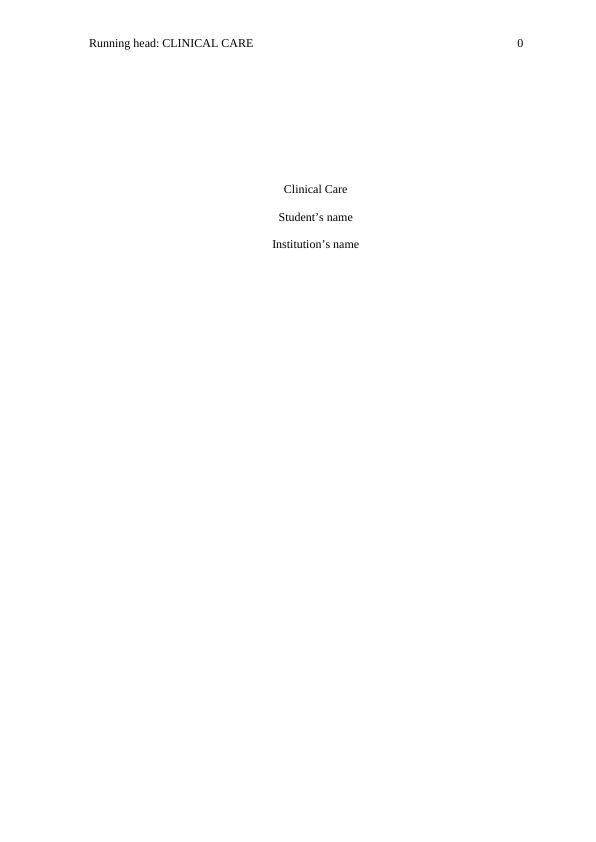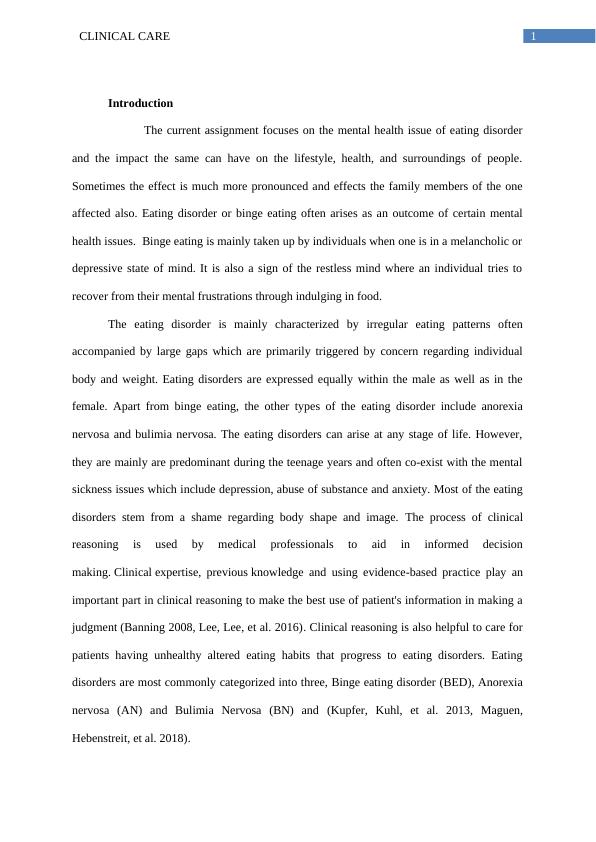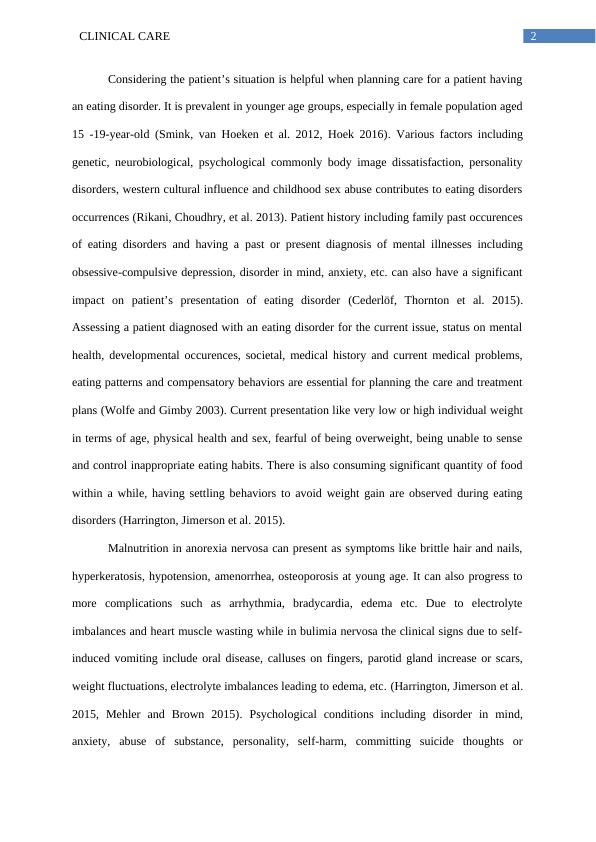Clinical Care for Eating Disorders: Assessment, Treatment, and Impact on Family and Community
Added on 2023-06-13
18 Pages5122 Words281 Views
Running head: CLINICAL CARE 0
Clinical Care
Student’s name
Institution’s name
Clinical Care
Student’s name
Institution’s name

1CLINICAL CARE
Introduction
The current assignment focuses on the mental health issue of eating disorder
and the impact the same can have on the lifestyle, health, and surroundings of people.
Sometimes the effect is much more pronounced and effects the family members of the one
affected also. Eating disorder or binge eating often arises as an outcome of certain mental
health issues. Binge eating is mainly taken up by individuals when one is in a melancholic or
depressive state of mind. It is also a sign of the restless mind where an individual tries to
recover from their mental frustrations through indulging in food.
The eating disorder is mainly characterized by irregular eating patterns often
accompanied by large gaps which are primarily triggered by concern regarding individual
body and weight. Eating disorders are expressed equally within the male as well as in the
female. Apart from binge eating, the other types of the eating disorder include anorexia
nervosa and bulimia nervosa. The eating disorders can arise at any stage of life. However,
they are mainly are predominant during the teenage years and often co-exist with the mental
sickness issues which include depression, abuse of substance and anxiety. Most of the eating
disorders stem from a shame regarding body shape and image. The process of clinical
reasoning is used by medical professionals to aid in informed decision
making. Clinical expertise, previous knowledge and using evidence-based practice play an
important part in clinical reasoning to make the best use of patient's information in making a
judgment (Banning 2008, Lee, Lee, et al. 2016). Clinical reasoning is also helpful to care for
patients having unhealthy altered eating habits that progress to eating disorders. Eating
disorders are most commonly categorized into three, Binge eating disorder (BED), Anorexia
nervosa (AN) and Bulimia Nervosa (BN) and (Kupfer, Kuhl, et al. 2013, Maguen,
Hebenstreit, et al. 2018).
Introduction
The current assignment focuses on the mental health issue of eating disorder
and the impact the same can have on the lifestyle, health, and surroundings of people.
Sometimes the effect is much more pronounced and effects the family members of the one
affected also. Eating disorder or binge eating often arises as an outcome of certain mental
health issues. Binge eating is mainly taken up by individuals when one is in a melancholic or
depressive state of mind. It is also a sign of the restless mind where an individual tries to
recover from their mental frustrations through indulging in food.
The eating disorder is mainly characterized by irregular eating patterns often
accompanied by large gaps which are primarily triggered by concern regarding individual
body and weight. Eating disorders are expressed equally within the male as well as in the
female. Apart from binge eating, the other types of the eating disorder include anorexia
nervosa and bulimia nervosa. The eating disorders can arise at any stage of life. However,
they are mainly are predominant during the teenage years and often co-exist with the mental
sickness issues which include depression, abuse of substance and anxiety. Most of the eating
disorders stem from a shame regarding body shape and image. The process of clinical
reasoning is used by medical professionals to aid in informed decision
making. Clinical expertise, previous knowledge and using evidence-based practice play an
important part in clinical reasoning to make the best use of patient's information in making a
judgment (Banning 2008, Lee, Lee, et al. 2016). Clinical reasoning is also helpful to care for
patients having unhealthy altered eating habits that progress to eating disorders. Eating
disorders are most commonly categorized into three, Binge eating disorder (BED), Anorexia
nervosa (AN) and Bulimia Nervosa (BN) and (Kupfer, Kuhl, et al. 2013, Maguen,
Hebenstreit, et al. 2018).

2CLINICAL CARE
Considering the patient’s situation is helpful when planning care for a patient having
an eating disorder. It is prevalent in younger age groups, especially in female population aged
15 -19-year-old (Smink, van Hoeken et al. 2012, Hoek 2016). Various factors including
genetic, neurobiological, psychological commonly body image dissatisfaction, personality
disorders, western cultural influence and childhood sex abuse contributes to eating disorders
occurrences (Rikani, Choudhry, et al. 2013). Patient history including family past occurences
of eating disorders and having a past or present diagnosis of mental illnesses including
obsessive-compulsive depression, disorder in mind, anxiety, etc. can also have a significant
impact on patient’s presentation of eating disorder (Cederlöf, Thornton et al. 2015).
Assessing a patient diagnosed with an eating disorder for the current issue, status on mental
health, developmental occurences, societal, medical history and current medical problems,
eating patterns and compensatory behaviors are essential for planning the care and treatment
plans (Wolfe and Gimby 2003). Current presentation like very low or high individual weight
in terms of age, physical health and sex, fearful of being overweight, being unable to sense
and control inappropriate eating habits. There is also consuming significant quantity of food
within a while, having settling behaviors to avoid weight gain are observed during eating
disorders (Harrington, Jimerson et al. 2015).
Malnutrition in anorexia nervosa can present as symptoms like brittle hair and nails,
hyperkeratosis, hypotension, amenorrhea, osteoporosis at young age. It can also progress to
more complications such as arrhythmia, bradycardia, edema etc. Due to electrolyte
imbalances and heart muscle wasting while in bulimia nervosa the clinical signs due to self-
induced vomiting include oral disease, calluses on fingers, parotid gland increase or scars,
weight fluctuations, electrolyte imbalances leading to edema, etc. (Harrington, Jimerson et al.
2015, Mehler and Brown 2015). Psychological conditions including disorder in mind,
anxiety, abuse of substance, personality, self-harm, committing suicide thoughts or
Considering the patient’s situation is helpful when planning care for a patient having
an eating disorder. It is prevalent in younger age groups, especially in female population aged
15 -19-year-old (Smink, van Hoeken et al. 2012, Hoek 2016). Various factors including
genetic, neurobiological, psychological commonly body image dissatisfaction, personality
disorders, western cultural influence and childhood sex abuse contributes to eating disorders
occurrences (Rikani, Choudhry, et al. 2013). Patient history including family past occurences
of eating disorders and having a past or present diagnosis of mental illnesses including
obsessive-compulsive depression, disorder in mind, anxiety, etc. can also have a significant
impact on patient’s presentation of eating disorder (Cederlöf, Thornton et al. 2015).
Assessing a patient diagnosed with an eating disorder for the current issue, status on mental
health, developmental occurences, societal, medical history and current medical problems,
eating patterns and compensatory behaviors are essential for planning the care and treatment
plans (Wolfe and Gimby 2003). Current presentation like very low or high individual weight
in terms of age, physical health and sex, fearful of being overweight, being unable to sense
and control inappropriate eating habits. There is also consuming significant quantity of food
within a while, having settling behaviors to avoid weight gain are observed during eating
disorders (Harrington, Jimerson et al. 2015).
Malnutrition in anorexia nervosa can present as symptoms like brittle hair and nails,
hyperkeratosis, hypotension, amenorrhea, osteoporosis at young age. It can also progress to
more complications such as arrhythmia, bradycardia, edema etc. Due to electrolyte
imbalances and heart muscle wasting while in bulimia nervosa the clinical signs due to self-
induced vomiting include oral disease, calluses on fingers, parotid gland increase or scars,
weight fluctuations, electrolyte imbalances leading to edema, etc. (Harrington, Jimerson et al.
2015, Mehler and Brown 2015). Psychological conditions including disorder in mind,
anxiety, abuse of substance, personality, self-harm, committing suicide thoughts or

3CLINICAL CARE
depression are commonly comorbid with eating disorders; it is unclear whether these are
caused by or are a risk factor of an eating disorder (Herpertz-Dahlmann, Keski-Rahkonen and
Mustelin 2016).
For a patient diagnosed with this problem, it is important to consider the vast
possibilities of various medical and psychological co-morbidities, and hence a very
comprehensive patient assessment is essential to link the association of multiple diseases and
to formulate a treatment plan. Conventional diagnostic procedures for eating disorders
include SCOFF questionnaire, regular weight, height and body mass index measurements,
urinalysis to determine hydration status, ph. Level, kidney damage, routine blood pressure
measurements, electrocardiography, complete blood count, etc. (Harrington, Jimerson, et al.
2015). Deriving a pattern from the diagnosis and associated comorbidities a care plan can be
formulated by the treatment team. Attention is given to the severe medical conditions first
that may be life-threatening, for example, cardiac complications associated with the eating
disorder may require emergent hospitalization, after stabilizing those conditions focus can be
moved to improve the lifestyle and providing patient with psychological and medical support
to maintain that lifestyle.
Assessment of Eating Disorder
The occurrence of binge eating disorder within an individual could be
analyzed through comprehensive clinical assessment. As mentioned by Mehler & Andersen
(2017), the eating disorders are associated with the significant amount of health morbidities
as well as could also result in psychological distress. Some of the typical processes which
could be conducted by the attending physician to monitor the presence of eating disorder in
an individual are through routine laboratory tests, review of presenting symptoms, recording
vital health details of the patient and comparing them on each visit and conducting a
depression are commonly comorbid with eating disorders; it is unclear whether these are
caused by or are a risk factor of an eating disorder (Herpertz-Dahlmann, Keski-Rahkonen and
Mustelin 2016).
For a patient diagnosed with this problem, it is important to consider the vast
possibilities of various medical and psychological co-morbidities, and hence a very
comprehensive patient assessment is essential to link the association of multiple diseases and
to formulate a treatment plan. Conventional diagnostic procedures for eating disorders
include SCOFF questionnaire, regular weight, height and body mass index measurements,
urinalysis to determine hydration status, ph. Level, kidney damage, routine blood pressure
measurements, electrocardiography, complete blood count, etc. (Harrington, Jimerson, et al.
2015). Deriving a pattern from the diagnosis and associated comorbidities a care plan can be
formulated by the treatment team. Attention is given to the severe medical conditions first
that may be life-threatening, for example, cardiac complications associated with the eating
disorder may require emergent hospitalization, after stabilizing those conditions focus can be
moved to improve the lifestyle and providing patient with psychological and medical support
to maintain that lifestyle.
Assessment of Eating Disorder
The occurrence of binge eating disorder within an individual could be
analyzed through comprehensive clinical assessment. As mentioned by Mehler & Andersen
(2017), the eating disorders are associated with the significant amount of health morbidities
as well as could also result in psychological distress. Some of the typical processes which
could be conducted by the attending physician to monitor the presence of eating disorder in
an individual are through routine laboratory tests, review of presenting symptoms, recording
vital health details of the patient and comparing them on each visit and conducting a

End of preview
Want to access all the pages? Upload your documents or become a member.
Related Documents
The impact of media on the development of eating disorderlg...
|9
|1938
|67
Abnormal Psychologylg...
|4
|742
|146
Clinical Interventions for Binge Eating Disorderlg...
|12
|3121
|374
Eating Disorders: Anorexia and Bulimialg...
|7
|632
|68
References: Brownell, K. D., & Walsh, B. T.lg...
|2
|434
|65
The Assignment on Mental Health and Illnesslg...
|7
|1718
|22
